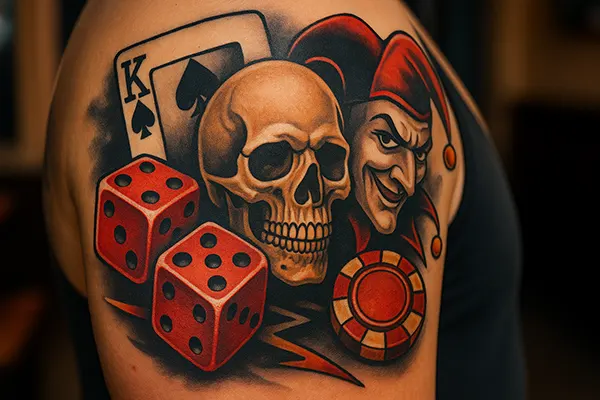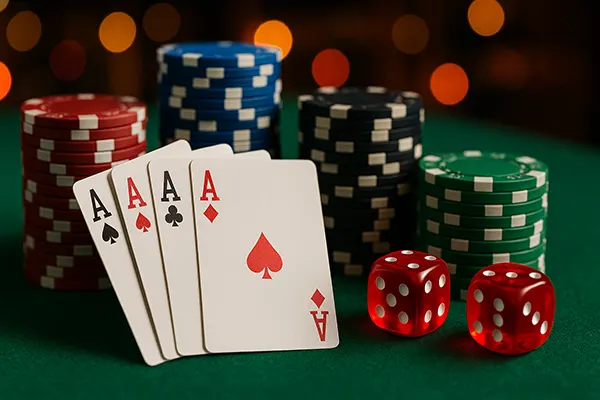
Gambling-Themed Tattoos: Philosophy and Myths Etched in Ink
From biker clubs to urban subcultures, gambling-themed tattoos have carved a distinctive place in body art, embodying symbols of luck, rebellion, and fate. These images, including cards, dice, and chips, are more than aesthetic choices — they tell stories, conceal codes, and reflect deeper personal philosophies. In 2025, this trend continues to grow, blurring the lines between game symbolism and the human search for meaning. This article dives into their cultural roots, their layered significance, and the myths they carry on the skin.
The Symbolic Language of Gambling Tattoos
Classic gambling symbols like aces, 777s, skulls with poker chips, and the Queen of Spades have developed a semiotic system of their own. Each tattoo often signals more than chance or fortune — it’s a coded message. For instance, a flaming ace of spades might stand for dominance and death, while a pair of red dice signals high-risk living. The ‘lucky 7’ serves as a talisman for success, especially in Western traditions where it evokes spiritual completeness.
People who choose these symbols often attribute personal significance to them. A 777 tattoo might commemorate a turning point in someone’s life where odds were beaten. Skulls paired with cards or chips frequently represent a defiant attitude toward life and death — a gambler’s readiness to risk everything in pursuit of a greater goal.
There’s also a spiritual aspect to these symbols. In some cases, the motifs are inked during critical life transitions, becoming permanent affirmations of resilience or risk-taking. The ink becomes a memory, a prayer, or even a pact with fate.
Decoding Aces, Jokers and Dice in Body Art
Aces are among the most popular gambling-themed tattoos, often representing victory or isolation. An Ace of Spades, specifically, holds military and death-related connotations — made famous by both soldiers and rock musicians. The Joker, on the other hand, carries duality: a wild card in games and a symbol of unpredictability or chaos in life.
Dice tattoos reflect one’s relationship with luck and fate. Rolled to land on specific numbers — usually 3 and 4 to symbolise “7” — they suggest calculated risk or blind optimism. Unlike decorative designs, these images often include cracks, flames, or eyes, adding psychological weight and meaning.
Whether worn as rebellion, a charm, or an inner compass, each icon amplifies a personal philosophy rooted in the randomness of life and the will to influence it. Tattoos of this kind are acts of defiance and devotion at once.
Subcultures That Popularised Gambling Tattoos
The rise of gambling-themed tattoos can be strongly traced back to subcultures like outlaw biker gangs, 20th-century mafias, and street crews. These groups adopted such imagery to represent courage, loyalty, and fatalism. A tattoo of a queen with a dagger may not only reference card games but also hidden codes of honour or revenge.
In biker culture, for example, a flaming card or snake-wrapped dice isn’t merely decorative — it’s a badge of identity. It may signify a personal mantra or a vow made under dangerous circumstances. Members ink these designs to mark pivotal moments, brotherhoods, or even crimes, making them both literal and symbolic records of life.
Urban street cultures evolved the aesthetic in more stylised ways — blending graffiti-style linework with traditional motifs. These communities introduced more vibrant colours and layered imagery, incorporating graffiti elements, street art aesthetics, and hip-hop symbolism with poker faces and slot wheels.
The Tattooed Rebellion Against Order
To many wearers, these tattoos aren’t just about gambling — they’re acts of resistance. Gambling symbols often accompany themes of anti-establishment, risk, and the randomness of life, serving as a visible pushback against systems that favour control and conformity. The dice become a protest, the Joker a metaphor for the unpredictable outsider.
This resistance is especially visible in prison tattoos, where gambling motifs express coded affiliations, psychological states, or existential beliefs. Within this context, even the suit of a card may carry secret meanings understood only within the inmate hierarchy.
These inked philosophies challenge the illusion of control — embracing uncertainty, luck, and personal sovereignty as defining forces of life. It’s not merely rebellion — it’s a worldview painted in ink.

Myth, Magic and Modern Relevance
Many gambling symbols also bear a magical or mythological past. The number seven, sacred in various cultures, is believed to connect to divine perfection. Similarly, dice were once used in ancient divination rituals. When such symbols are tattooed, they may channel a subconscious belief in destiny or universal order.
In recent years, tattoo artists have begun combining these mythic references with modern aesthetics. Tarot-style art, geometric compositions, and blackwork patterns have rejuvenated the gambling symbolism — attracting a new generation of wearers who see tattoos not only as fashion but also spiritual armour.
In 2025, gambling tattoos are increasingly seen on influencers, artists, and gamers, reflecting a fusion of retro aesthetics and digital-age identity. Their meanings evolve, but the core remains: risk, belief, and self-expression through symbols etched forever.
Fate Written on the Skin
The permanence of tattoos reinforces their weight. To tattoo a roulette wheel or a cracked poker chip is to accept the chaos of life as part of one’s story. For some, it is a form of surrender to randomness. For others, it’s a badge of control over the narrative — even when odds are unfavourable.
Myths about gambling tattoos — like gaining luck from a specific design or suffering misfortune if the ink is altered — continue to circulate in online communities and tattoo shops. Some wearers actively avoid placing certain designs near the heart, believing in symbolic consequences.
Ultimately, gambling-themed tattoos become personal legends. Whether rooted in folklore, philosophy, or fashion, they mirror the timeless dance between chance and choice — carried permanently in flesh and ink.
